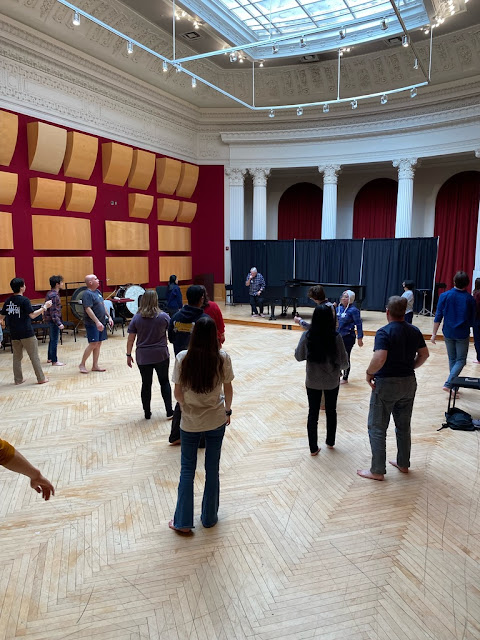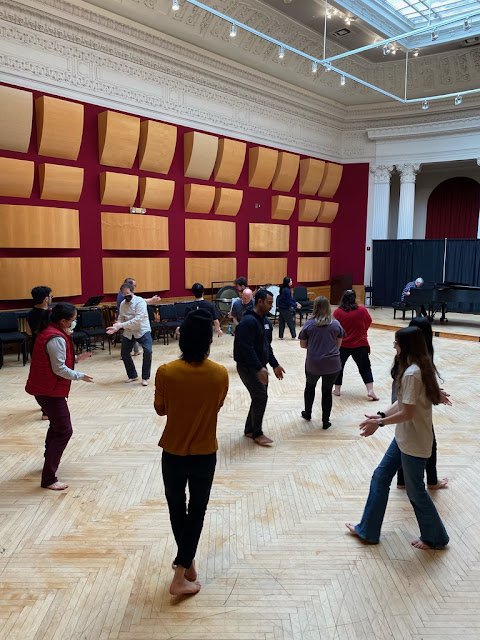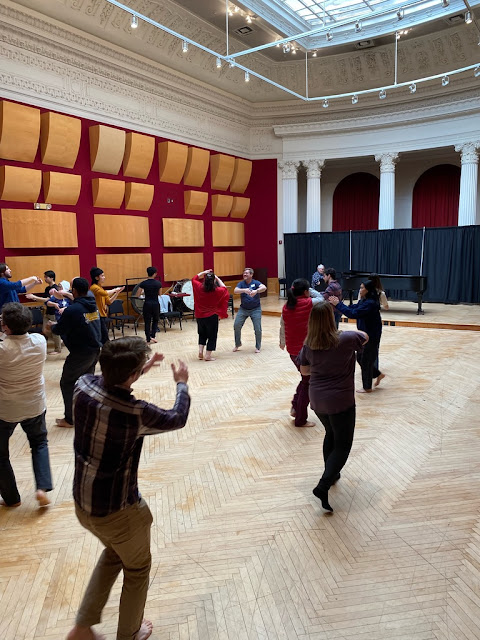Plastique Animée — What's it all about?!
Jaques-Dalcroze practices include a whole category of exercises under the title of Plastique Animée. These lessons ask the students to move and experiment and search and vet specific gestures in an attempt to pair bodied motion to musical motion. Through the process we come to learn about the music and build a very personal/visceral connection to a given selection of music.
I wrote about the ways that I use the traditional exercise in my university courses in the 2023 Fall edition of the Dalcroze Society of America, Dalcroze Connections. Plastique Animée —The Dalcrozian Analytical Technique. Here I thought I'd describe a set of experiences that are inspired from plastique, but serve a complementary role.
I spend many hours and many many smaller exercises building a group of 20 year olds up to a point where we can talk about Plastique Animée as a named category of Jaques-Dalcroze practice. In advance of that, we do all sorts of bodies-in-motion, expressive gesture, and movement vocabulary classes. The basic mechanics of "bodies move like this", and "here are some simple motions we might rehearse together" are obvious enough attentions for a good eurhythmics class and critical experiences for all students working toward a future Plastique Animée. In addition to those outward expressions of musical motion, I spend a significant amount of time asking my students to consider their own experience of inner gesture. How does music move on the inside of you? What skills of the interoceptive have you gained through our time together?
As a significant stop on the interoceptive skill journey, I often find time to lead my students through an experience I think of as the Reverse Plastique Animée.
In a traditional Plastique Animée, a selection of music is chosen, and the student uses the motion of the music to inspire outward gesture, searching for the greatest congruence between the intention of the music and interpretation of the performer/student. In the Reverse Plastique Animée, we go about it in the other direction. We start with silent gesture, separate from any pre-composed works or ideas, and then see what music is generated from the pure motion.
The basic class usually goes like this:
(keep in mind that we spend many hours getting to this work. I would not offer this class to a beginner group)
1. "You have 20 seconds to choose 4 'poses'."
These can be anything. i.e. stand tall arms above; squat down and hug your knees; lean far forward on one leg; bury your head in your arms in a small ball on the floor.
2. "turn each of these poses into a gesture phrase of its own."
We have spent weeks working on the notion of "phrase" and on simple gesture. We have explored the difference between basic motion and directional, trajectory-filled gesture. We have built up a movement vocabulary that includes gesture high-middle-low, gesture that collapses the body vs gesture that expands the body, and gesture that leads from hands vs gesture that takes any part of the body as the initiator of the motion.
3. "Find a way to link the four phrases together to make a 4-phrase gesture 'song'."
4. Step 4 is split between classwork and homework. We do some of this together over about 15 minutes and then the students are to spend significant time at home to continue the exercise.
"now take a breath, rest your thoughts, and take some time to move through the silent gesture song. Over the next 10–20–30 repetitions your song will start to sing to you. Listen to the sounds and images that start to appear as you settle in to the motions. Take notes on what starts to bubble up. These notes might contain specific bits of melody or harmonies or rhythmic patterns...or you might hear more abstract sounds like leaves rustling or traffic or children laughing, or who knows?!. It is all valid. Repeat your phrases again and listen to the music that comes out of the gesture. You do not need to compose anything. Instead, just listen to your inner song and take notes."
5. The 4-phrase gesture song above is the first section of an ABA form. For homework, the students are required to repeat the steps with contrasting gestures to then make the B section, taking notes on the sounds and images that occur to them as they go through the process. After a few days of checking in with their ABA songs in silence, they are instructed to compile their notes and turn them into a piece for their major instrument.
6. Roughly a week after the initial experience, the students all come back to class with their major instruments. They each take a turn first showing us their ABA gesture songs in silence. We watch, and listen to our own inner songs, trying to think, "how does this music sound?" They repeat the silent ABA gesture two times, then they get out their major instrument and play their songs two times — no gesture, just sound.
Throughout the exercise we are looking for congruence between the gesture and the sounded music. The students are reminded that we are not trying to "compose a little song and then choreograph a little dance." Instead, we are working hard to find sparks of the inner artist, space where we can hear the music that is already in us. The exercise is less about flexing our composer muscles than it is about listening to the inner song that was already there. Many of the compositions that are shared were surprises to the student movers. They report how the process permitted music that they would not normally have conceived. "The music is already in you."
I will write another day about the differences between inner hearing, or audiation, and inner feeling or interoceptive gesture — a serious component of deep musicianship. The Reverse Plastique Animée is intended to focus our attention on this inner feeling, and recognize the music found there.
[some pictures from my Spring 2023 Eurhythmics II class. used with permission.]

Arilyn brought the harp to class — so great!

Preston in motion.
Zach in motion.
Will in motion.
The new electronic music major at CMU has opened all sorts of doors and forced me to think differently about a number of my biases. It is amazing what our students are capable of. #humbled






























